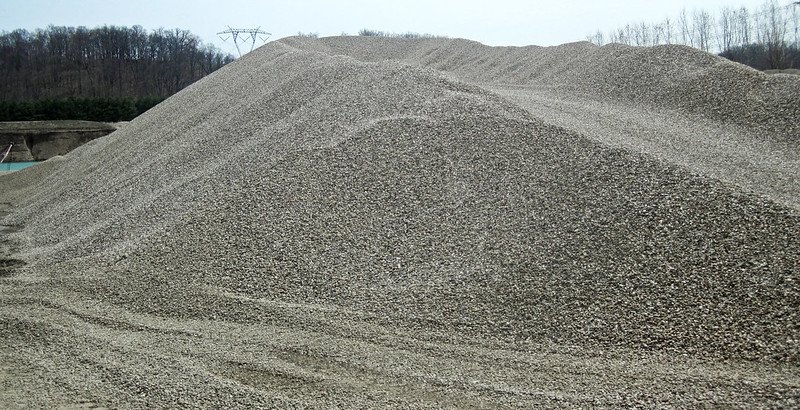Table of Contents Show
River floodplains, river channels, and glacier deposits all contribute to the formation of gravel, sand, and gravel deposits.
In the United States, around a billion tons of gravel and sand are produced each year. The United States offers an abundance of high-quality gravel and sand sediments.
It also possesses the technology to prepare the material to the high grade required for almost any use, such as construction, landscaping, and water treatment.

Gravel and sand were the most readily available natural resources for construction material in the early days of civilization.
These materials had little usage in the twentieth century; however, gravel and sand production now ranks second (after crushed stone) in the non-fuel minerals market, eventually becoming some of the most sought-after aggregate materials in construction.
Below I have compiled a list of the top 5 most popular (and fundamental) usages for these aggregative materials. Let’s take a look:
General Construction
Sand and gravel are required in the production of concrete. These materials are utilized in a variety of construction projects and serve as the foundation for our cities.
Cement, mortar, plaster, concrete, and blocks all contain sand and gravel.
These aggregates are utilized in the construction of foundations for houses, schools, hospitals, and other structures of various sizes.
Roads, highways, bridges, skyscrapers, walkways, parking lots, and cycling routes are all constructed using them.
Concrete and Asphalt
Aggregates account for approximately 80% of the weight of ready-mixed concrete. Sand and gravel are used to make a variety of concrete building components, including concrete bricks, blocks, and pipes.
The majority of asphalt (about 95 percent) is made up of aggregates. Asphalt is also used to make roofing and shingles, in addition to paving roadways.
Read Also:
- 7 Things You Need to Know Before Refinishing Hardwood Floors with Floor Sanding
- What are the Different Types of Aggregates and How Do You Use Them
- How to Sand Drywall Fast (Sanding Patch, Mud, Corners, Ceiling)
- The Importance of Getting the Right Quality of Sand
- How to Reduce Dust When Sanding Drywall
- Tips on Sanding Between Deck Boards
Driveways and Walkways
Crushed gravel and utility sand in a concrete mix or gravel laid alone can be used for driveways.
When utilizing gravel, it’s best to arrange it in three layers: the largest on the bottom (3-4 inches in diameter), the medium in the middle (2-3 inches in diameter), and crushed gravel on top (3/8 inch in diameter).
On the other hand, aggregates of all kinds can be used to construct walkways. If you want a barefoot-friendly walkway (for example, from your pool to your house), select softer aggregates with a smooth texture and rounded edges, such as finer sand and smaller gravel with a 14-inch or smaller diameter.
Erosion Control and Landscaping
Soil erosion is widespread in locations such as house drain pipes, embankments, and the bottoms of hills.
In landscapes, gravel and sand are used to avoid soil erosion. The soil will become compacted, strong, and secure by covering the eroding regions with gravel, utility, or fill sand.
When it comes to landscaping, gravel and sand are commonly used as filler in pathways, flower garden borders, walkways, and other areas.
They come in a range of sizes and colors to suit your landscaping requirements.
Icy Roads, Driveways, and Walkways
On ice roads, railroads, sidewalks, driveways, and walkways, sand and gravel are also utilized as safety measures.
Throughout the winter, these aggregates offer traction to avoid slips, falls, and skidding on ice.
Usage Requirements
When wanting to implement gravel and sand in a home project or construction, one needs to be aware of the government specifications that come with their implementation.
Aggregates must fulfill unique standards for a specific purpose in construction in some circumstances, as mandated by state governments.
A certain grade or aggregate may be specified in some contracts. The contract’s Special Provision section contains information on these specific accommodations.
Below are the general requirements for fine and coarse aggregates both in which sand and gravel fall.
Fine Aggregates
The acid-insoluble content of fine aggregate, including blended fine aggregate, used in HMA (hot mixed asphalt) Surface 4.75 mm mixes must be at least 40%.
The acid-insoluble percentage of air-cooled blast furnace slag or granulated blast furnace slag sand must not be less than 25% for this application.
Crushed gravel, limestone, and dolomite sands do not meet the acid-insoluble criteria. ITM 202 Test is used to determine the acid-insoluble content.
Coarse Aggregates
A specific criterion for all coarse aggregates is that the quantity of flat and elongated particles be limited.
The number of flat and elongated components is limited differently depending on the state where the project is done.
A flat and elongated item is one with a length-to-thickness ratio of higher than five. The ASTM D 4791 is the test technique for determining the actual proportion of elongated fragments.
Before going forth with your gravel and sand project, it is crucial for you to get government approval.
The details listed above should help you in determining whether or not your project falls short of any of these specifications.
If further assistance is needed, feel free to contact your local quarry or freight broker, they will be sure to assist and help you with all your aggregate needs.









